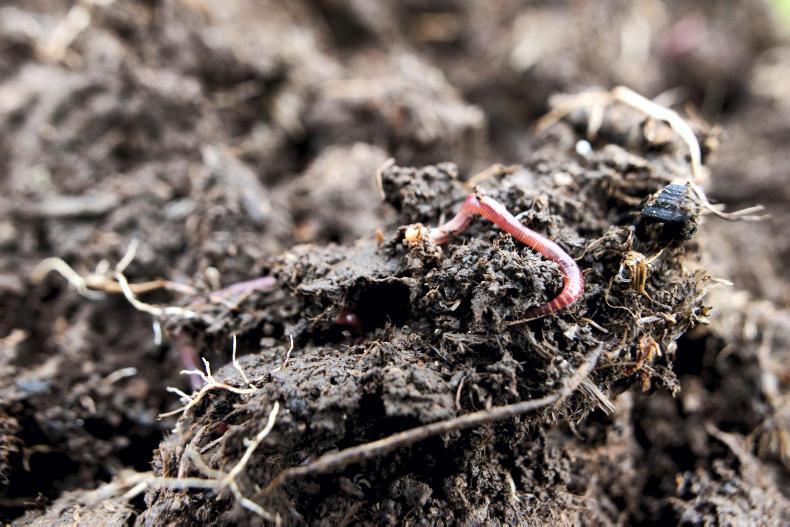The work earthworms do on our farms should never be under-estimated. They play a vital role in the breakdown of plant litter and manure. Earthworms distribute the nutrients through their excrement along the soil profile, leaving behind worm casts.
The blending of organic substances, microorganisms and fine mineral soil particles, which occurs during the digestion process in earthworms, releases plant nutrients and helps to restructure soil to improve land in the long term.

Worm casts on top of the soil is a sign that earthworms are active.
Earthworms do not add nutrients to the soil, but they do make nutrients more available for plant uptake after they pass through the worm. Studies have shown that earthworms excrete available nitrogen and mucus all the time and the amounts are significant.
Earthworms extrude slime from their skin to help lubricate their movement and this contains a lot of available nitrogen, which is deposited along the burrow. Farmers interested in maintaining productive soils need to make sure they are farming in a way that promotes earthworm activity.
Some farmers believe that slurry kills earthworms, but according to specialists this is not the case. Studies have shown that slurry application at normal rates either had no effect or had a positive effect on earthworm populations. After slurry application you might see some dead worms on top of the soil.

Planting a small number of trees on the farm every year is a gift for future generations.
These worms most likely came to the surface to feed and died as a result of UV light exposure. With 5,000,000 worms per hectare, the percentage of worms that die after slurry spreading is minuscule. Here are four tips to ensure earthworms have every chance to thrive in your soil.
1. Conditions
Earthworms thrive best where there is food, moisture, a favourable temperature and little disturbance. Having an overall good soil fertility status will be good for earthworms. Spreading partially decomposed FYM on land is very beneficial. This decaying matter is a good feed source for the worms and it will lead to an increase in numbers. Slurry also has a part to play in feeding earthworms, but applications have to be carefully planned. Avoid spreading slurry when fields are very wet and try not to spread it too thick. Little and often may be a better approach rather than one large, thick coat.
2. Cautious tilling
Avoid tilling land excessively, especially during active times. Earthworms tend to be very active in March/April and September/October, so if you can avoid tilling land too much during these periods you will help to maintain numbers. Irish research has shown that minimum tillage techniques can help in this regard.
3. Balanced pH
Research carried out in Irish grassland showed that worm populations expanded when nitrogen input increased. However, there are limits to the amount of chemical nitrogen that Irish farmers can spread and too much nitrogen can lead to soil acidity. Earthworms are sensitive to soil pH and numbers will drop if the pH drops below five, in this scenario lime applications will help.
4. Reduce soil traffic
during wet periods
Compacted soils do not suit earthworms. If soil is very compacted it makes it harder for earthworms to burrow through and do their work. By alternating your tracks when travelling on the land, you will reduce the damage done to the soil. Avoid travelling on the ground when it is very wet and do not let animals out in wet weather. Conditions like these can have a negative effect on earthworm populations.
The work earthworms do on our farms should never be under-estimated. They play a vital role in the breakdown of plant litter and manure. Earthworms distribute the nutrients through their excrement along the soil profile, leaving behind worm casts.
The blending of organic substances, microorganisms and fine mineral soil particles, which occurs during the digestion process in earthworms, releases plant nutrients and helps to restructure soil to improve land in the long term.

Worm casts on top of the soil is a sign that earthworms are active.
Earthworms do not add nutrients to the soil, but they do make nutrients more available for plant uptake after they pass through the worm. Studies have shown that earthworms excrete available nitrogen and mucus all the time and the amounts are significant.
Earthworms extrude slime from their skin to help lubricate their movement and this contains a lot of available nitrogen, which is deposited along the burrow. Farmers interested in maintaining productive soils need to make sure they are farming in a way that promotes earthworm activity.
Some farmers believe that slurry kills earthworms, but according to specialists this is not the case. Studies have shown that slurry application at normal rates either had no effect or had a positive effect on earthworm populations. After slurry application you might see some dead worms on top of the soil.

Planting a small number of trees on the farm every year is a gift for future generations.
These worms most likely came to the surface to feed and died as a result of UV light exposure. With 5,000,000 worms per hectare, the percentage of worms that die after slurry spreading is minuscule. Here are four tips to ensure earthworms have every chance to thrive in your soil.
1. Conditions
Earthworms thrive best where there is food, moisture, a favourable temperature and little disturbance. Having an overall good soil fertility status will be good for earthworms. Spreading partially decomposed FYM on land is very beneficial. This decaying matter is a good feed source for the worms and it will lead to an increase in numbers. Slurry also has a part to play in feeding earthworms, but applications have to be carefully planned. Avoid spreading slurry when fields are very wet and try not to spread it too thick. Little and often may be a better approach rather than one large, thick coat.
2. Cautious tilling
Avoid tilling land excessively, especially during active times. Earthworms tend to be very active in March/April and September/October, so if you can avoid tilling land too much during these periods you will help to maintain numbers. Irish research has shown that minimum tillage techniques can help in this regard.
3. Balanced pH
Research carried out in Irish grassland showed that worm populations expanded when nitrogen input increased. However, there are limits to the amount of chemical nitrogen that Irish farmers can spread and too much nitrogen can lead to soil acidity. Earthworms are sensitive to soil pH and numbers will drop if the pH drops below five, in this scenario lime applications will help.
4. Reduce soil traffic
during wet periods
Compacted soils do not suit earthworms. If soil is very compacted it makes it harder for earthworms to burrow through and do their work. By alternating your tracks when travelling on the land, you will reduce the damage done to the soil. Avoid travelling on the ground when it is very wet and do not let animals out in wet weather. Conditions like these can have a negative effect on earthworm populations.












SHARING OPTIONS